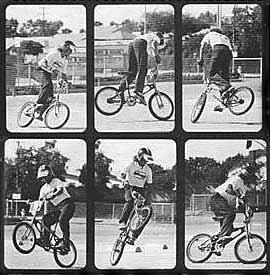Paul Crow, www.vintagebmx.com, february 2005: As to the birth of freestyle, I’m bettin’ it started about 45 seconds after the birth of the bicycle.
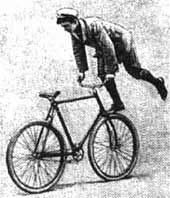


Yamaha introduces a fully suspended kids bike called the Moto-Bike. The manufacturers figured that the kids wanted to be like motorcycles, so... "Hey! Let's make gas tanks, fenders, and put shocks on the bikes!" Neat idea, huh?
It went that way for a while. Everyone dumped their Stingrays for the mono-shocks.
Marvin Church, a local So. Cal. hotshoe, appeared at the tracks on a custom used-to-be Stingray frame that his dad made. It sported welded straight tubes for the front triangle and a higher bottom bracket allowing use for longer 6" inch cranks.

In Chatsworth, a BMX father named Linn Kastan creates the first pair of tubular BMX forks in the workshop of his company - Redline, a speedway motorcycle frame builder.
About the same time, another BMX dad (and part-time drag racer) named Skip Hess is working on the first mag wheels for BMX bikes. Little did he know, at the time, that the MotoMag would sell millions.
Following Yamaha's footsteps, Kawasaki introduces an aluminum shocker. Part-time Hollywood stunt-man and part-time motorcycle gas-tank maker Gary Littlejohn and his partner Murphy, adds the first production rigid BMX frame to his line of products that already included sidehacks and mono-shocks. Towards the end of '74, mono-shocks died and rigid frames were born.
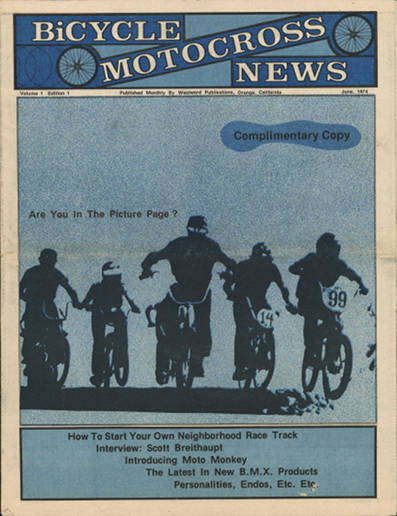
Skateboarder, february 1980: Spring, 1975. Escondido "reservoir", San Diego County, Southern California. Pre-park skaters gather here daily to try the smooth walls of this dry cement pond. Local skaters sometimes ride up the dirt trail on Stingrays and BMX prototypes occasionaly taking two-wheel passes. A few more committed bikers usually riding during odd hours cut loose moves and lines that rival anything else going down.
Fall, 1975. Carlsbad Skatepark. California's first skatepark is found to be highly functional terrain for a hardy crew of bike advocates. Their carves in the bowl are as high and rad as those of their skating peers, and the moguls seem well suited to their dirt nurtured jumps. Warren Bolster, then editor of Skateboarder, phoographs the creme providing historical reference. Pictures of BMX pool riding were published in Skateboarder Magazine.
Thom Lund and John Palfreyman are riding the Key Hole pool in Beverly Hills.
Thom Lund, Dig, november 2002: KeyHole was big, deep and round. 13 foot deep with a fair amount of dirt. You had to go up the wall, let the front wheel pop off the coping, pull it to the side and drop the front wheel back in the pool. You had to do this across the bottom and up the other side, going back and forth.
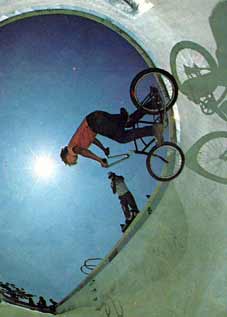
Randy Davila. Photo: Warren Bolster.
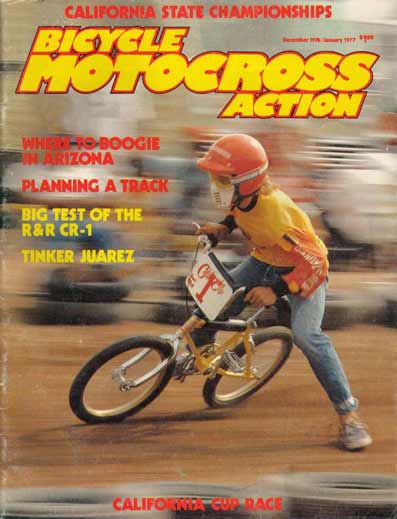
Bob Haro, www.fatbmx.com: I first rode skate-parks in 1976-77. Learning tricks, rollbacks, kick-turns, fakies, etc.
Alain Kuligowski, journaliste Français, ramène un BMX en France et le présente à Marcel Seurat, importateur de motos à Beaune qui prend la décision de fabriquer des BMX, copies conforme du modèle américain et qui seront signés de la marque « Bicross ».
In '78, you were definitely a nobody unless you had a pair of Red Line V bars clamped to your stem. Your stem was probably an Ashtabula (if you were short on cash), or a Mongoose or Cook Bros. (if you were rich). Still, no matter what your cash flow was, Red Line V's were HOT items. The hot bike was a Mongoose. Tinker Juarez, Brian Curnell, Jeff Kosmala, Kenny Knachman, and Dan Oakley were the Factory 'Goose squad. All of those guys ripped.
First issue of Bmx Plus! in november.
Pour faire connaître ces vélos d’un genre nouveau en France, il faut des courses. Quatre clubs vont ainsi voir le jour : Beaune, Altkirch, Delle et Romans. Le premier club est créé à Beaune en février 1978. La Fédération Française de Bicrossing est créée le 1er mars 1978. OTB dessine un aerial dans les pages du magazine Moto Verte.
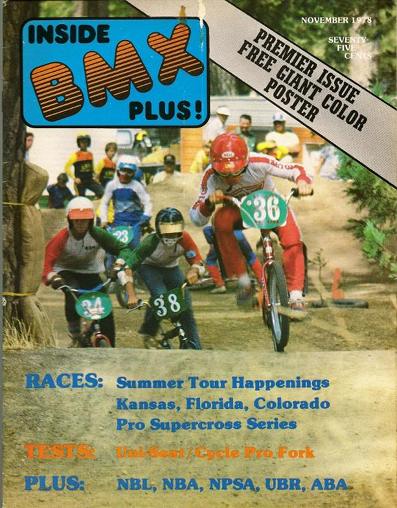
Skateboarder, february 1980: Summer, 1979. Rocky Mountain Surf Skatepark Salt Lake City, Utah. Skateboarder staff photographer Jim Goodrich, on special assignment, happens upon a BMX demo here during a major skate competiton. Evidently, park two-wheeling has become more widespread and advanced than we originally thought. Park two-wheeling borrows maneuvers from dirt riding, especially free-form jumping, as well as from skating. Turning the wheel to the side in the air is called a cross-up. BMXers are also pulling off drop-ins, fakies, stalls, slides, 180 aerials, wheelie variations and a wide variety of hybrid moves.
Winter, 1979. Southern California promoters and park owners are discussing injecting BMX park events into their 1980 competition schedules Rumors to this effect have already spread through the grapevine and local bike enthusiasts are reportedly gearing up.
